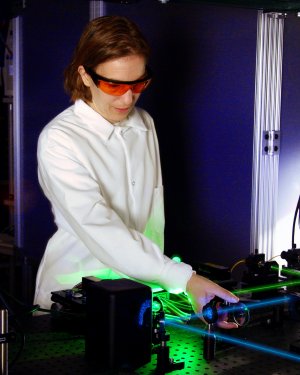Jerilyn Timlin, a chemist at Sandia National Laboratories, has been presented by the National Institutes of Health (NIH) with a New Innovator Award, one of 55 such awards granted by the NIH this year. The award encourages researchers to explore bold ideas that have the potential to catapult fields forward and speed the translation of research into improved health.
 Sandia chemist Jeri Timlin will use her National Institutes of Health (NIH) award to develop state-of-the-art imaging technology that can measure protein complex formation and protein networks. (photo by Lloyd Wilson)
Sandia chemist Jeri Timlin will use her National Institutes of Health (NIH) award to develop state-of-the-art imaging technology that can measure protein complex formation and protein networks. (photo by Lloyd Wilson)
Timlin received the award for her project “Multiplexed measurements of protein dynamics and interactions at extreme resolutions.” The work will aim to develop state-of-the-art imaging technology that can measure protein complex formation and protein networks in a multiplexed fashion with spatial resolution beyond that of the optical microsopy.
“I am so grateful to have this opportunity to equip the field of biological imaging with a new analytical tool for visualizing and quantifying multiple protein interactions,” said Timlin. “I am honored to play a key role in growing Sandia’s bioscience programs at the NIH.” Timlin’s award is for $1.5 million over five years.
A total of 115 awards have been granted by NIH under three innovative research programs supported by the NIH Common Fund’s Roadmap for Medical Research: the NIH Director’s Transformative R01 (T-R01) Awards, Pioneer Awards, and New Innovator Awards. The Common Fund supports cross-cutting, trans-NIH programs with a particular emphasis on innovation and risk taking. A portion of these New Innovator Awards is also supported by funding from the American Recovery and Reinvestment Act.
“The appeal of the Pioneer, New Innovator, and now the T-R01 programs, is that investigators are encouraged to challenge the status quo with innovative ideas, while being given the necessary resources to test them,” said NIH Director Francis S. Collins. “The fact that we continue to receive such strong proposals for funding through the programs reflects the wealth of creative ideas in science today.”
More information on the New Innovator Award is at http://nihroadmap.nih.gov/newinnovator. For descriptions of the 2009 recipients’ research plans, see http://nihroadmap.nih.gov/newinnovator/Recipients09.asp.